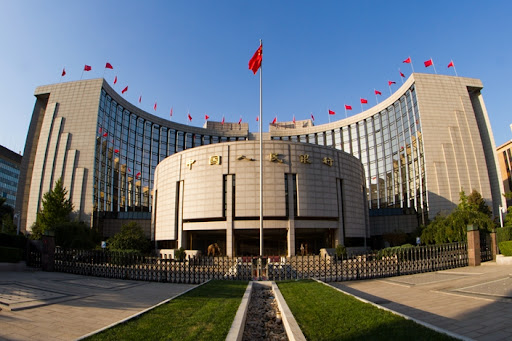
The Bank of Japan (BOJ)
29/07/2024
Understanding Stock Market Volatility: A Comprehensive Guide
30/07/2024How the People’s Bank of China Influences Markets: A Comprehensive Guide
Introduction to the People’s Bank of China (PBOC)
The People’s Bank of China (PBOC) is the central bank of the People’s Republic of China and plays a crucial role in the country’s financial and economic system. As the primary institution responsible for formulating and implementing monetary policy, the PBOC influences various aspects of the Chinese economy and global markets. This comprehensive guide explores the structure, functions, tools, and impact of the PBOC on both domestic and international markets.
Structure and Functions of the PBOC
Structure of the PBOC
The PBOC operates under the authority of the State Council of China. Its organizational structure includes:
- Governor: The Governor is the head of the PBOC, appointed by the National People’s Congress.
- Deputy Governors: Several Deputy Governors assist the Governor in managing the PBOC’s various functions.
- Departments and Branches: The PBOC has numerous departments and regional branches to carry out its policies and operations across China.
Functions of the PBOC
The PBOC performs several key functions, including:
- Formulating and Implementing Monetary Policy: The PBOC designs and executes monetary policies to control inflation, manage liquidity, and support economic growth.
- Regulating Financial Institutions: The PBOC oversees banks and other financial institutions to ensure stability and compliance with regulations.
- Managing Foreign Exchange Reserves: The PBOC manages China’s vast foreign exchange reserves to maintain exchange rate stability and support international trade.
- Issuing Currency: The PBOC has the exclusive authority to issue and manage the national currency, the renminbi (RMB).
- Conducting Financial Research: The PBOC conducts extensive economic and financial research to inform policy decisions.
Tools of the PBOC
1. Interest Rate Policy
The PBOC sets benchmark interest rates to influence borrowing costs, investment, and consumer spending. Key interest rates include the one-year lending rate and the one-year deposit rate. Adjusting these rates helps control inflation and stimulate or cool down economic activity.
Example:
Lowering interest rates makes borrowing cheaper, encouraging businesses to invest and consumers to spend, thus stimulating economic growth. Conversely, raising interest rates helps control inflation by making borrowing more expensive and reducing spending.
2. Reserve Requirement Ratio (RRR)
The RRR is the percentage of deposits that banks must hold in reserve and not lend out. By adjusting the RRR, the PBOC can influence the amount of money available for lending.
Example:
Lowering the RRR increases the amount of money banks can lend, boosting liquidity and stimulating economic activity. Raising the RRR reduces the money supply, helping to control inflation and prevent overheating of the economy.
3. Open Market Operations (OMOs)
OMOs involve the buying and selling of government securities to manage liquidity in the financial system. The PBOC uses OMOs to inject or withdraw liquidity from the banking system, thereby influencing interest rates and credit conditions.
Example:
Purchasing securities injects liquidity into the banking system, lowering interest rates and encouraging lending. Selling securities withdraws liquidity, raising interest rates and curbing lending.
4. Medium-term Lending Facility (MLF)
The MLF is a tool used by the PBOC to provide medium-term funding to banks. By offering loans with longer maturities, the PBOC can influence medium-term interest rates and support stable credit conditions.
Example:
Providing medium-term funding at favorable rates encourages banks to extend more loans to businesses and consumers, supporting economic growth.
5. Foreign Exchange Interventions
The PBOC intervenes in the foreign exchange market to manage the value of the renminbi (RMB) relative to other currencies. By buying or selling foreign currencies, the PBOC can influence the exchange rate to achieve economic and trade objectives.
Example:
Selling foreign currencies and buying RMB strengthens the RMB, making Chinese exports more expensive and imports cheaper. Buying foreign currencies and selling RMB weakens the RMB, making exports cheaper and imports more expensive.
6. Window Guidance
Window guidance involves informal communication and guidance provided by the PBOC to financial institutions regarding their lending practices and other activities. This tool helps the PBOC influence credit conditions without formal policy changes.
Example:
The PBOC may advise banks to increase lending to certain sectors, such as small and medium-sized enterprises (SMEs), to support economic growth and employment.
Impact of the PBOC on Domestic Markets
1. Inflation Control
The PBOC uses its monetary policy tools to manage inflation by influencing demand and supply dynamics in the economy. Controlling inflation helps maintain price stability, protect purchasing power, and create a conducive environment for economic growth.
2. Economic Growth
By adjusting interest rates, reserve requirements, and liquidity conditions, the PBOC can stimulate or cool down economic activity. These measures support sustainable economic growth and help achieve the government’s economic objectives.
3. Financial Stability
The PBOC plays a critical role in maintaining financial stability by regulating financial institutions, managing liquidity, and preventing systemic risks. Its actions help ensure the stability and resilience of the banking system and broader financial markets.
4. Exchange Rate Management
The PBOC’s interventions in the foreign exchange market help manage the value of the RMB, supporting China’s trade competitiveness and economic stability. A stable exchange rate fosters investor confidence and reduces exchange rate volatility.
5. Credit Conditions
Through tools like interest rate policy, RRR adjustments, and window guidance, the PBOC influences credit conditions in the economy. These measures impact borrowing costs, lending practices, and overall credit availability, affecting business investment and consumer spending.
Impact of the PBOC on Global Markets
1. Trade and Investment Flows
As the central bank of the world’s second-largest economy, the PBOC’s policies significantly impact global trade and investment flows. Changes in China’s monetary policy can influence global demand for commodities, intermediate goods, and capital flows.
Example:
A monetary easing policy by the PBOC can boost Chinese demand for raw materials and intermediate goods, benefiting exporters of these products worldwide.
2. Global Financial Markets
The PBOC’s actions can affect global financial markets, including stock, bond, and foreign exchange markets. Investors closely monitor the PBOC’s policy decisions for clues about China’s economic outlook and potential market impacts.
Example:
A significant policy change, such as a large-scale liquidity injection by the PBOC, can boost global stock markets by improving investor sentiment and increasing risk appetite.
3. Exchange Rates and Currency Markets
The PBOC’s interventions in the foreign exchange market influence the value of the RMB and other currencies. Changes in the RMB’s value can impact global trade balances, competitiveness, and capital flows.
Example:
A stronger RMB can reduce China’s trade surplus by making its exports more expensive and imports cheaper, affecting global trade dynamics.
4. Commodity Prices
China is a major consumer of commodities, and the PBOC’s policies can influence global commodity prices. Monetary easing can boost demand for commodities, driving up prices, while tightening can reduce demand and lower prices.
Example:
Increased infrastructure spending supported by the PBOC’s monetary easing can lead to higher demand for steel and copper, raising global prices for these commodities.
5. Spillover Effects
The PBOC’s policy decisions can have spillover effects on other economies, particularly those with close trade and financial ties to China. Changes in Chinese demand, investment flows, and financial conditions can impact economic growth and stability in other countries.
Example:
Monetary tightening by the PBOC can reduce Chinese demand for imports, negatively impacting export-oriented economies that rely heavily on Chinese markets.
Case Studies: PBOC Policy Actions and Their Impact
Case Study 1: The Global Financial Crisis (2008-2009)
Background
During the global financial crisis, the PBOC implemented aggressive monetary easing measures to support the Chinese economy and mitigate the impact of the global downturn.
Actions
- Interest Rate Cuts: The PBOC lowered benchmark interest rates to reduce borrowing costs and stimulate economic activity.
- Reserve Requirement Ratio (RRR) Cuts: The PBOC reduced the RRR to increase liquidity in the banking system and encourage lending.
- Fiscal Stimulus Coordination: The PBOC supported the government’s fiscal stimulus measures, including infrastructure spending and consumer subsidies.
Impact
- Domestic Economy: The PBOC’s actions helped stabilize the Chinese economy, supporting a rapid recovery and sustained growth.
- Global Markets: Increased Chinese demand for commodities and goods supported global economic recovery and boosted commodity prices.
Case Study 2: COVID-19 Pandemic (2020-2021)
Background
The COVID-19 pandemic caused significant economic disruptions globally, prompting central banks, including the PBOC, to implement extraordinary measures to support their economies.
Actions
- Interest Rate Cuts: The PBOC lowered benchmark interest rates to reduce borrowing costs and support economic activity.
- Liquidity Injection: The PBOC conducted large-scale open market operations and provided funding through the Medium-term Lending Facility (MLF) to ensure adequate liquidity.
- Targeted Support: The PBOC provided targeted support to sectors and businesses most affected by the pandemic, including SMEs.
Impact
- Domestic Economy: The PBOC’s measures helped stabilize the Chinese economy, facilitating a swift recovery and return to growth.
- Global Markets: The PBOC’s actions supported global economic stability and recovery by maintaining China’s role as a major driver of global demand.
Criticisms and Challenges
1.
Transparency and Communication
The PBOC has faced criticism for its lack of transparency and clear communication compared to other major central banks. Improved transparency and communication can enhance market confidence and predictability.
2. Balancing Growth and Stability
The PBOC faces the challenge of balancing economic growth with financial stability. Rapid economic growth can lead to financial imbalances, while efforts to maintain stability can constrain growth.
3. Managing Debt Levels
High levels of corporate and local government debt in China pose risks to financial stability. The PBOC must manage these risks while supporting economic growth and preventing financial crises.
4. Global Coordination
As China’s influence in the global economy grows, the PBOC must coordinate its policies with other major central banks to address global economic challenges and maintain stability in international markets.
Conclusion
The People’s Bank of China (PBOC) plays a vital role in shaping China’s economic and financial landscape. Through its monetary policy tools and regulatory functions, the PBOC influences inflation, economic growth, financial stability, and exchange rates. The PBOC’s actions have significant implications for both domestic and global markets, impacting trade, investment, commodity prices, and financial market stability. Understanding the role and influence of the PBOC is essential for comprehending the dynamics of the Chinese economy and its interactions with the global economic system.



